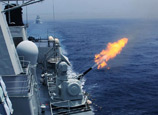
SHANGHAI, July 12 (Xinhua) -- A joint venture between DreamWorks Animation (DWA) and its Chinese partners is preparing to open an indoor theme park in China, a move to test the water in the budding market.
The theme park is scheduled to showcase animated figures created by the U.S. cartoon studio, including characters from Hollywood blockbuster "Kung Fu Panda," revealed Shuai Min, vice president of the Shanghai-based Oriental DreamWorks (ODW), on Friday.
Shuai told Xinhua in an exclusive interview on the sidelines of the ongoing China International Comics Games Expo in Shanghai that the park is planned to be built in "a major city" in the Yangtze River Delta.
He did not reveal the exact location or a timetable for the project.
Indoor theme parks, which can create significant added value, will be a direction for the company's long-term development, according to Shuai.
"Compared with an open-air park, an indoor one is smaller, cheaper and more attractive to consumers, families particularly, who live downtown," he said, citing successful cases in Japan and Europe.
In addition, there is increasing competition in the Chinese market for outdoor amusement parks, according to the ODW vice president.
In April 2011, ODWs domestic rival in the animation field, Disney, began the construction of the Shanghai Disney Resort, the first Disney theme park on the Chinese mainland.
A year later, ODW and its Chinese partners announced plans to establish a "Dream Center" entertainment zone in Shanghai that will comprise theaters, restaurants and bars, stressing the tourist attraction is not a theme park.
Founded in 2012 with three Chinese firms holding a majority 55 percent stake in the company, ODW primarily focuses on animation production based on stories with deep connections to China.
Shuai also disclosed the long-anticipated "Kung Fu Panda 3," a 3D co-production between ODW and DWA, is expected to be released by the end of 2015, a bit earlier than the previous estimation of 2016.
"The script has been finished and production will soon start. What the work demonstrates is not just 'Chinese elements,' but profound Chinese culture and rich local flavor," Shuai said.
Kung Fu Panda and Kung Fu Panda 2, which respectively played in cinemas in 2008 and 2011, each harvested a box office of over 100 million yuan (16.3 million U.S. dollars) in the Chinese market, with tickets worth 470 million yuan being sold for the latter.
ODW is expected to produce its first original animated film in 2017 and three proposals are competing for the production, according to Shuai.
"The film will be based on subjects related to China's traditional culture while reflecting the pursuit of values by modern Chinese," he said.
Now the world's second-largest film market, China will replace the United States as the largest in a few years to come, DreamWorks CEO Jeffrey Katzenberg predicted in a June interview with Xinhua.
China's box office surged 30.18 percent year on year to hit 17.07 billion yuan in 2012. In the past decade, the number of screens in the country's cinemas had leapt from some 1,800 in 2002 to more than 13,000 by the end of 2012.
In addition to cartoon films, ODW has also mulled producing TV animation series in the future and forging further cooperation with TV channels nationwide, according to Shuai.
"What is certain is that the stories and characters in the TV shows will be very Chinese," he said.
















 Typhoon Soulik kills one in Taiwan, brings rainstorms to Fujian
Typhoon Soulik kills one in Taiwan, brings rainstorms to Fujian


![]()
